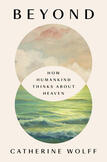
The afterlife is having a moment. ‘Beyond’ will help Christians and nonbelievers alike discuss what lies beyond the grave.
The afterlife is having a moment.
In the past two years, no fewer than three well-publicized books by prominent intellectuals have explored the history and ethics of heaven and hell. While David Bentley Hart sought to challenge the justice of eternal damnation in That All Shall Be Saved and Bart Ehrman argued in Heaven and Hell that Christianity invented its afterlife with scant help from Jesus, Catherine Wolff’s new book Beyond is a gentler and more personal journey. In it, she mixes well-written impressionistic summaries of various religious perspectives with personal anecdotes to answer the age-old question of what lies beyond the grave.
This book is not for anyone who wants to understand what a religious group thinks or believes about the afterlife. For that you will need a small library. It does hold promise, however, for the non-linear reader who wants to dip into a set of beautifully curated vignettes about particular thinkers or topics. For example, if you wanted to learn in roughly three pages what Islam really says about jihad and the “seventy-two virgins” mentioned in the Quran, Wolff has you covered.
More than anything else, Wolff is a reassuring guide for the spiritually curious Christian. She often relies upon anecdotes and conversations with friends and colleagues, which is not necessarily a weakness, as her coterie is filled with impressive scholars and thought leaders. A talented curator, Wolff has synthesized, organized and summarized these key thinkers and perspectives into easily digestible small chapters.
More than anything else, Catherine Wolff is a reassuring guide for the spiritually curious Christian.
Though it is not a history of the afterlife, Beyond is chronologically organized. Beginning with Neanderthals and what Wolff calls “primal” religion, we learn about shamanic and indigenous beliefs. From there we move to “Ancient Religion,” the eternally popular theories of the Egyptians and Mesopotamians regarding the afterlife, then on at breakneck speed through Judaism to Christianity, and then Islam. Hinduism and Buddhism find themselves as bedfellows in part six. Part seven melds science, psychedelics, transhumanism and near-death experiences into a tidy final section about our current age.
The scope of the book is audacious but not Promethean, as this is well-trodden ground. The Afterword tells us what Wolff herself knew from the beginning: “There are no definitive answers” and we should be open to the many potential ways of experiencing the divine. Whether that encounter is through prayer, meditation, ritual or hallucinogenic substances is up to us.
At the heart of this book is an admirable desire to demonstrate that the secular and the spiritual do not have to be sharply divorced from one another. Christians do not have to be afraid of the religious and spiritual inquiries of others. Science is not the proverbial bogeyman. Even the Eleusinian mysteries, banned by the Christian emperor Theodosius I in 392 C.E., are presented as friendly attempts to answer eternal questions. The open, ecumenical spirit of the book is infectious and engaging. The non-Christian, the simply spiritually curious, the cafeteria Catholic and the smorgasbord Lutheran will have much to think and talk about.
While the personal anecdotes that punctuate the work provide refreshment from Wolff’s eloquent but rich summaries of various arguments and thinkers, they also dilute the quality of the material. Wolff makes a conscious choice to “rely on believers” over scholars, but some precision and detail has been lost along the way. Though erudite, the book often lapses into broad generalizations.
Ideas about the afterlife tell us more about the hopes, fears and priorities of those speaking than they do about heaven and hell.
I teach classes about life after death every year, and I tell my students that ideas about the afterlife tell us more about the hopes, fears and priorities of those speaking than they do about heaven and hell. In this respect, Wolff is no exception. While she protests that this is not a history, she organizes her discussion of various theories on the afterlife as if it were and has made revealing choices about what to include and when.
For instance, the section on Christianity is almost twice as long as any other section and remains a touchstone throughout the book. (To her credit, Wolff is honest about her Christian bias.) Indigenous religions garner only a few paragraphs at the very beginning of the book alongside a discussion of “primal people.” We progress in an intellectual ascent toward modern science, bypassing the ancient philosophers who had also asked scientific questions about cosmology and the afterlife.
The truth is that humans of every age have believed that they stood on the cusp of uncovering the secrets to eternal life. We are not so special.
It is perhaps because of this that I selfishly wish that Wolff could have tackled the oppressive structural hierarchies at play in descriptions of the afterlife in a more systematic fashion. While she briefly discusses Muslim theories about the moral inferiority of women, she does not mention the early Christians, some of whom also wondered if women would have to “become male” to enter the kingdom of God (e.g., Gospel of Thomas 114). Similarly, her brief discussion of Swedenborg’s idea of women as heavenly childcare providers does not acknowledge that this expands and mirrors something dark and patriarchal: In the Latin Vision of Ezra, women are condemned for failing to breastfeed the children of strangers.
Gender, disability, race, identity and power have recently been the subject of important books about the afterlife by Meghan Henning and Taylor Petrey. (Full disclosure, I myself have also written about disability and the eradication of identity in heaven.) Ideas about the hereafter can inflict harm as well as provide comfort, so it is disappointing that Wolff does not think about the kinds of lives, experiences and bodies implicitly devalued in her presentation of her own vision of heaven. Though Wolff’s book is more of a quest than a historical account, every pilgrim should be aware of the environmental costs they incur on behalf of others in their journey.
Missed opportunities, however, are surely not the fault of Wolff—who writes clearly and has done enormous amounts of research—but are due to the scope of the project. If the truth of what happens when we die is unknowable, then documenting that truth in 300 pages is impossible. Fortunately, Wolff suggests, we have an eternity to explore its complexities.
Editor’s note: An earlier version of this story erroneously stated that Catherine Wolff uses the term "primitive" religion to describe shamanic and indigenous beliefs. The actual term used in Wolff's book to describe these beliefs is "primal."









